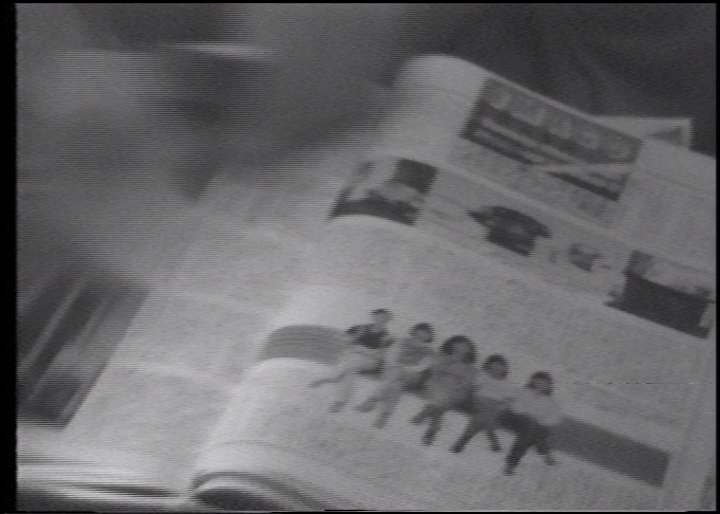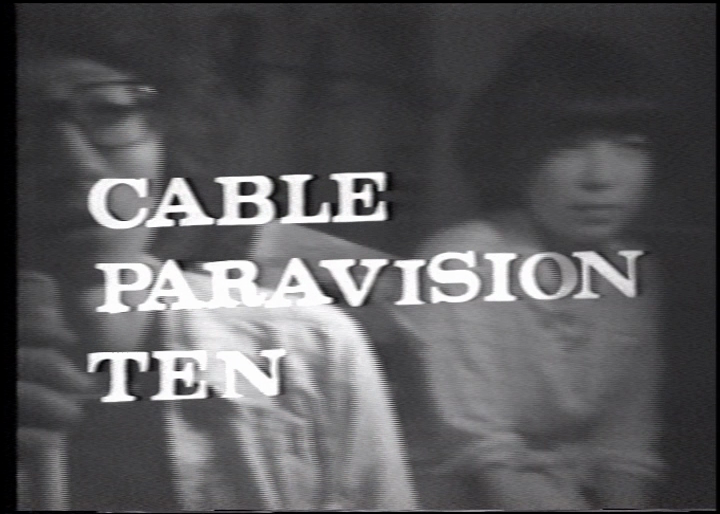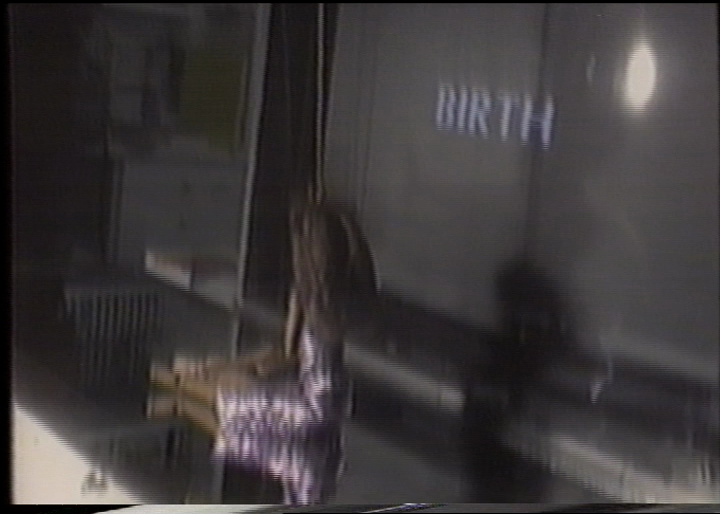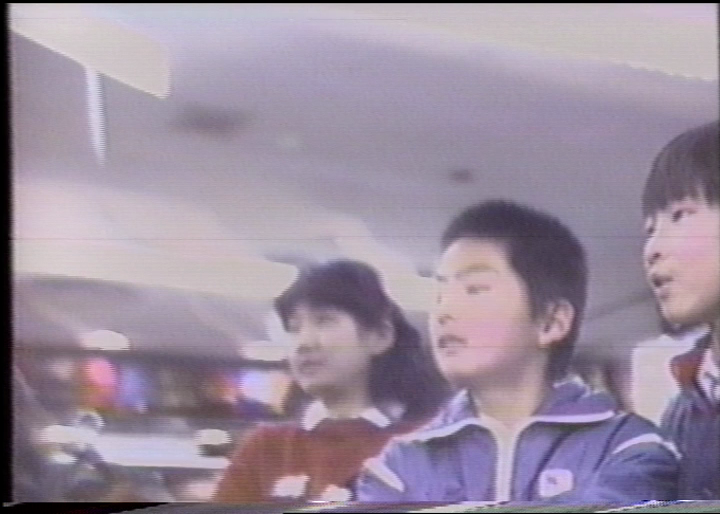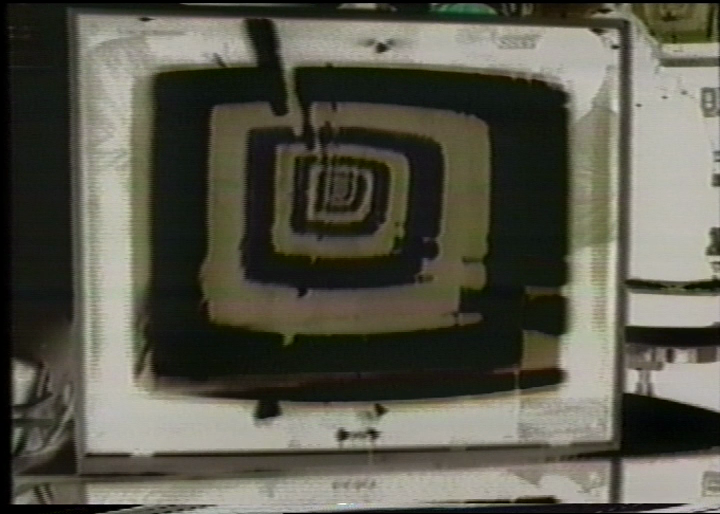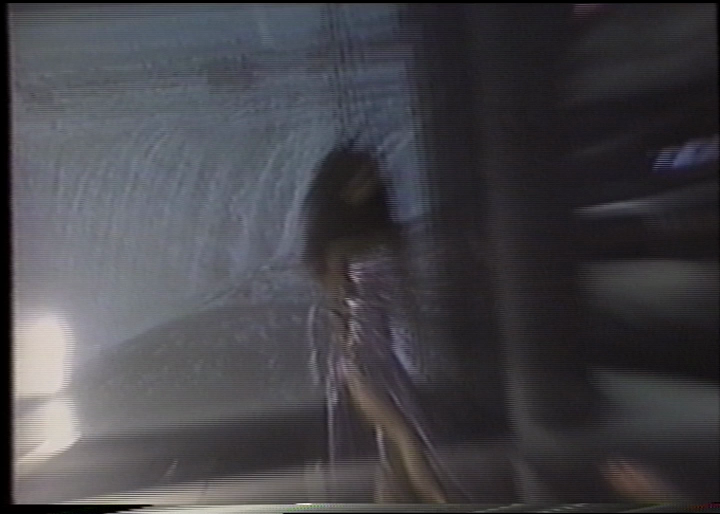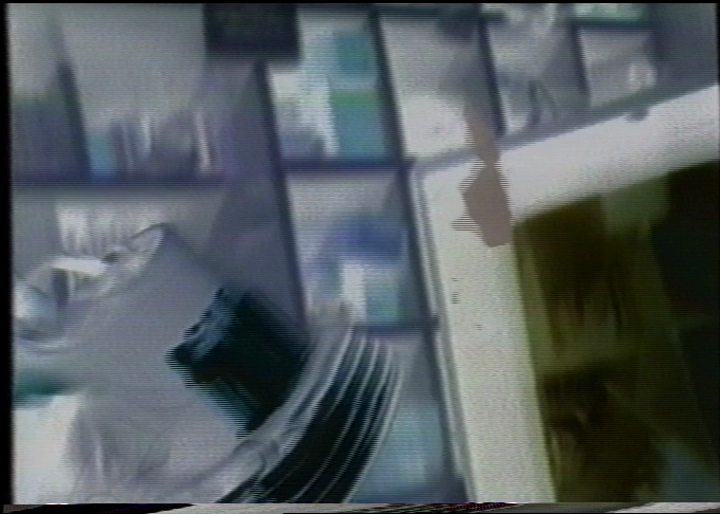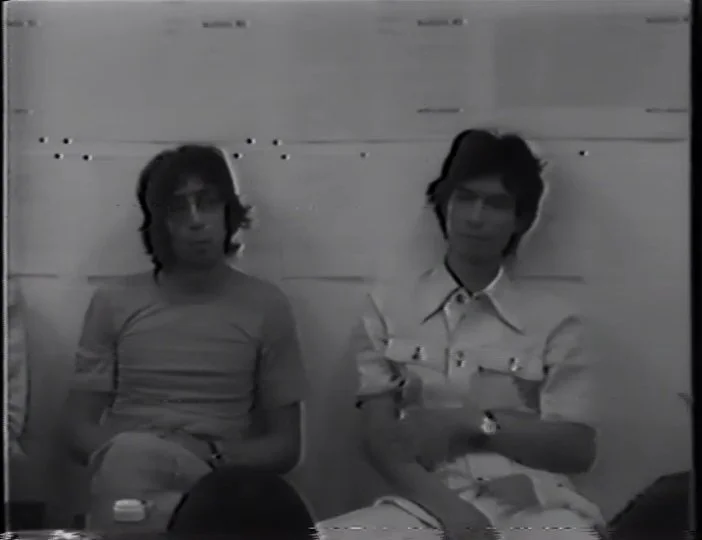
Essay: Multiple Para-Visions! ―― on VIC’s Remoteness and Closeness (Hitoshi Kubo)
We are thrilled to present a new translation of an essay by Hitoshi Kubo on the media strategy of the Video Information Center, first published in KUAC Cinematheque 1: Video is a Toy! VIC #1 (Keio University Art Center, 2017).
Multiple Para-Visions!―― on VIC’s Remoteness and Closeness / Big Events and Small Events
Hitoshi Kubo
Translated by Kwon Eugene
28th February 1982 A video is a toy cardboard (KUAC_VIC844)
In conjunction with our three-month online program of the works of the Video Information Center in partnership with Hitoshi Kubo and Keio University Art Center, we are thrilled to present an essay by Hitoshi Kubo first published in KUAC Cinematheque 1: Video is a Toy! VIC #1 (Keio University Art Center, 2017).
“A chronicler who recites events without distinguishing between major and minor ones acts in accordance with the following truth: nothing that has ever happened should be regarded as lost for history. To be sure, only a redeemed mankind receives the fullness of its past-which is to say, only for a redeemed mankind has its past become citable in all its moments. Each moment it has lived becomes a citation à l'ordre du jour — and that day is Judgment Day.”
Walter Benjamin, “Thesis on the Philosophy of History [On the concept of history] Ⅲ”[1]
In 1982, an event titled “A Video is A Toy [3] Cardboard” sponsored by VIC (Video Information Center), was held at Seibu Sports in Kichijōji. It was a workshop which set out to construct and destroy a video equipment set (TV, monitor, video-camera & video-deck) that had been created with cardboard, ten times bigger than an actual set. In the recorded moving image, we see the VIC members at the center, together with participants who are moving around, drawing creations, cutting the cardboard, assembling, destroying and cleaning up through the viewpoint of the presenter, Mr. Yoshinobu Kurokawa (moderator).
Consider the following phrase that was used by VIC:
“If you use a pair of scissors and parcel tapes, everyone can make it. Even if you don’t know anything about electricity, you can create a video. We have entered into such an era.” [2]
This phrase captures the zeitgeist of that period concerning videos in the 80s through a light sense of humor. [3] Naturally, what can be created, using cardboard, a pair of scissors and parcel tape is not video equipment but a toy version of it. However, the phrase—“video can be created”— describes not only being able to create a toy by using cardboard, but also being able to use a “video (set)” easily just like making a toy and playing with it for fun by analogy. The image of public participants with the VIC members in the huge toy TV-monitor made with cardboard in order to take a memorial photo at the end of the event literally indicates as well as embodies the following point: that recorded moving images of this event will be shown (at the same time or later) on a monitor (Fig.1). In other words, the general public participants were filming / producing a video as an analogy, playing for fun with toys.
Fig. 1: 28th February 1982 A video is a toy cardboard (KUAC_VIC844)
The era has just started being possible to film and disclose it to the public, even if people were not professionals in the moving images. However, VIC’s title of this event, “A video is a Toy,” doesn’t indicate that merely anyone can use a video easily, or that it was created solely to promote the sales of the video stores they run. There was yet another event organized by the VIC that had a similar drive. What is its motif so to speak?
In 1977, “CATV Sawano-sō (Apartment Cable TV)” opened. VIC rented a room in the apartment, Sawano-sō in Mitaka city in Tokyo, as its studio and connected all its 10 rooms using a CCTV cable. It broadcast various topics such as interviews, discussions with residents, today’s news and documentaries for two years. It was an experiment of the possibility of having in place a video system with a small scale network. The name of the program was CABLE PARAVISION TEN (Fig. 2). At the beginning of the program, which was broadcast each day, Mr. Ichirō Tezuka commented about its intent.
“Television is a device to view tele (from afar)… Paravision is an opposite idea to view para (near). It is an idea that a near place is far.”[4]
What does “para is tele” mean? At that time, television broadcasting was managed and operated by massive organizations as part of mass media, distributing primarily programs sponsored by affluent backers and filtered information. The tele of the program was similar to looking at Mt. Fuji from a far distance (viewing tele-place). When you look at Mt. Fuji from a far distance, you can see very clear and distinct information (Mt. Fuji) in which the congestion as well as the confused and indistinct information is organized, with the “boundary” (outline) emphasized. The closer one gets, the more Mt. Fuji blends into forests and rocks, losing its boundaries as a mountain, becoming crowded and ambiguous. The nearer the information is, the more information we have to edit through our own experience. The “para is tele” is an aphorism directed towards the elusiveness of various phenomena occurring around us which mass media never deals with (regardless of major events or small events). It represents a discomfort and refusal towards the one-way reception of the processed Tele-vision (far-vision). This phrase connects tele (distance) with “far”, criticizing the practice of only accepting clear, easily understood "distant-images" from television. In contrast, VIC aimed to embrace and confront this "close (para)-image" (a complex, ambiguous elusiveness) using video as a means to intervene and engage with it. [5]
Fig. 2: 5.27 Para Vision Ten 5.27 (KUAC_VIC1033)
In 19th December 1981, A Video is a Toy Workshop [6] VIC had an experiment in order to think how videos can control this “tele” and “para” (Fig. 3). It was the moving image created by a puppet in a female costume who was dancing with music on the mirror, being spotlighted with the video monitor in the background. At first, the puppet sits still on the mirror as if it is dead. But it gradually starts moving when the music starts and goes along with the indication of “BIRTH” on the monitor behind it. The puppet spins and jumps as if it is reproducing the sight of a discotheque scene. Its movement looks very vivid as if it is animated. As the focus shifts, blurs, and various effects like solarization are applied, we are continuously prompted to consider in which formation the puppet’s dance groove seems to change (intensify or diminish). And even if it is zoomed-in too much or it becomes the moving image of a silhouette like a camouflage pattern, as long as we feel that something is moving, we are forced to feel the puppet’s groove. It makes viewers think about the mechanism in which the viewers are absorbed in the fiction. When the figures of the participants at the workshop who were watching this sight are montaged and they are shown on the monitor, it works as a mirror image of themselves being absorbed and caught in the reflection of their absorption. However, they are soon covered with the groove again and its objectivity disappears. When the sound is turned down at the point of 24 minutes and 14 seconds from the beginning and the moving image develops without sounds, the groove which we had felt is torn apart. We clearly understand that the harmony of the sounds and the moving images had created the groove, once they are separated we will watch the next moving image with uneasiness. Filming the monitor itself creates an infinite nesting of monitors (feedback effect), which further spirals as the camera is slightly tilted. It was expressed in the existence of the frame (video system) to absorb into the object and spatiotemporal (before & after, outside & inside) the endlessness of the groove which was torn apart. After two minutes of silence, the act continues and when our uneasiness and tension rose up, the sound comes back again and the torn apart groove starts up to connect again. If it is expatiated, this phenomenon embodies the “tele-vision” and “para-vision” of which the video system is capable of exploring at a very simple level. What is exposed vividly here is that the safe “tele” is hardly destroyed - once you are absorbed in it, “para” only appears as a sense of incongruity by un-synchronization. And it makes us think about what a fictional reality the video system (TV system) creates. [7]
Fig. 3: 19th December 1981 A video is a toy workshop (KUAC_VIC830)
From the beginning of VIC establishment this awareness of the issues towards “tele”and “para” as well as the usage of videos as its solution has been targeted.
In 1972, VIC was born at the ICU (International Christian University) drama circle named “ICU Mini Theater.” In the “VIDEO-INFORMATION CENTE[R] establishment prospectus,” the following motive was stated:
“We made this society aiming to create a more active and general place for exchanging information between all the ICU members. Currently, the information media in ICU are the public relations section (gazette for the university [school gazette]) and the newspaper society. […] They have been keeping their activities under their own characteristics respectively. However, this characteristic is producing a big restriction in one aspect. In short, its function is not sufficient to convey the fact or the information as much as possible to all the ICU members. […] They are all limited to the printing media. V.I.C. (Video Information Center) has commenced, aiming at a more complete picture of things (including moving images and the sounds) and accuracy as well as prompt information exchange —ultimately, communication.” [8]
The awareness of issues and the suggestion for their solution which has been stated here is clear. First of all, as there is no possible way for all the ICU members to exchange the information, they are creating it. “Whole information exchange” means exchange among all the ICU members, and at the same time, not only information exchange by print media with printed matter as its center, but also moving images and sounds. Apart from the accuracy and the swiftness of transmission which printed matter has, it needs “accuracy and swiftness.” When these are integrated, communication becomes possible. There is no doubt that moving images and sound are factors which are missing in printed matter and videos can compensate for it. Also, if recorded tapes are replayed as they are, it is “swifter” than the edited printed matter. [9] However, what does it mean for information exchange to become “accurate”? The important issue here is that “communication ” hasn’t come yet to VIC and it is not something which is given but the idea to which they aim. Words such as “more” or “insufficient” indicates about the whole, accurate and prompt “information exchange,” in other words, communication as an idea is approached gradually. It is not the sort of thing which is concluded by some crucial structure or method. In another words, it should be achieved by various trials and errors. It is the “information” which conveys the “fact” that is “accuracy.” Media with printed matter as the center can handle paintings or photos as one part of the information, but they can neither move nor produce sound. Some facts move as well as generate sound. In other words, they have the process of time. Regarding describing the processes of time in sound-image, videos can offer the information of a “fact” relatively “accurately.” A certain fact is more “accurate” being informationized with a moving image and sound (even if it is a certain perspective through a camera and a microphone) by videos with relatively less reduction than the text (paintings or photos) which were contracted by a certain perspective. What was the background behind VIC’s intention to have this kind of communication as its founding principle?
In 1974, an article which introduced VIC’s activities could be read in Heibon Punch:
“In 1972, two years ago, the impression of a cold campus without communication was revealed at ICU more so than other universities. In the late 60s, unexceptionally, the campus dispute developed, known as the “Nooken -3 headlines dispute”. It parted from “university autonomy” as a theme. It can be said that it was the students’ resistance towards the “united politics and learning – industry and university cooperation.” […] The characteristic factor in ICU was the university authority’s attitude. The “measures against the dispute” of the stubborn university authority came to be an issue. […] As a result of the university authority’s effort, what supported a revival of “peace” in the ICU was the iron-board reverse-barricade surrounding the campus. It was the authority’s “belief” which prohibited any activities of the council. “Even though the university had the similar scale as a high-school with a total of 1200 students, the communication among the students had been cut off. It is not the case that it’s good if you are absorbed in talk, smiling, but I wanted to create the atmosphere in which people can exchange information from all directions. I was thinking all the time how it could be carried out.’” said Mr. Ichirō Kizuka [Ichirō Tezuka] […] who looked back at the time when the Video Information Center had started. […] He continued, “Television which makes excellent use of the information conveying method such as letters, sound and moving images profusely was very attractive. I wanted to gamble on the possibility of TV which demonstrates great power for conveying a fact most objectively as well as intentionally.’”[…] Among their many aims with television, there were the following things. TV requires the most powerful capital strength among the information industries. Naturally, the information which comes into your living room can’t be helped to connect straight to the system. It is difficult to find a space where an individual takes part in the one-way circuit which connects politics and your living room. In the background of morning-shows, many ordinary wives appear on the TV monitor. That sort of thing can’t be called participation in TV. VIC’s big aim was to carry out another circuit through the TV in order to participate in TV essentially.” [10]
In 1969, a forcible removal of the students who had held the ICU was conducted by the riot squad. A bricolage-like barricade which had been built to hold up, using chairs and desks was destroyed and the reverse-barricade to shut students out was built by the university. That’s “the iron-board reverse-barricade surrounding the campus.” To students, this was the time when the barricade to fight with the resisting authority changed into the barricade which suggests the impossibility of resistance. It was the communication between the university (both system and staff) and the students as well as the communication between resisting students and non-resisting ones (with different ideologies) which Mr. Tezuka had called “all directions,” that were cut off symbolically by the reverse-barricade. VIC picked up videos as a method to undertake, face and intervene the “tele” and “para” among the entire membership of the ICU symbolized by the barricade.
In 1973, the ICU-Festival was held for the first time in 4 years. At this festival, VIC had an event to reproduce a part of this “reverse-barricade” (Fig.4). On the pamphlet of the ICU Festival (15th), by VIC, read:
Fig. 4 The barricade which was reproduced by VIC in the ICU campus (1973)
“The second and third three headlines!?! That barricade!! That tremulous excitement!! Once again!! Come!! People who are apprehensive!! The second and third barricades!! The second November barricade!! Oh, that barricade with love!! Let’s dance barricade-rock together!! Reviving the barricade, reproducing a life and a friendship group, a society to protect the ICU’s serenity. Opposing violence and understanding each other through talks group. Determined group to go through everything. Agreeing everything without conditions group.” [11]
Rabble-rousing with humor and irony like the above was written (Fig. 5). It was agitation not only among the students but also all “apprehensive people” including the students, the staff and those present. The “three headlines” in “the second and third three headlines” refers to the “Nooken-3 headlines dispute” as well as the “three headlines ” as the point at issue in dispute between the university authority and the students. In other words, this didn’t mean that “peace” had arrived after something had been solved, but it suggested that there were various themes to communicate about what had been concealed under the “peace.” “Opposing violence and understanding each other through talks group” expressed the fact that VIC hadn’t given up on communication even after the reverse-barricade had been erected. “Determined group to go through everything” was their determination to do their best for it and “Agreeing everything without conditions group” expressed their attitude to affirm all events. On the next page, the diagram of the barricade was drawn and the reason why they were reproducing the “reverse-barricade”was written (Fig.6):
Fig. 5: [VIC : Ichiro Tezuka] “the 2nd and 3rd headings !?! […]” (15th ICU-Festival 23rd-25th February, 15th ICU-Festival Central Executive Committee ed., 1973, p.19.
“No.1: I think a threshold [kekkai] (barricade) is essentially one of the forms of a short-circuit. The skeletal frame is supported by two segments, just like the perpendicular line which goes down to the base of an isosceles triangle. No. 2: When you look up at the CD (barricade) from point A and from point B, one is supported by concrete material (pipes) and the other is by the two definitely non-concrete things, so both look disabled from each other. The lower part is a little possible to depict (drawing) and the upper part dominates the territory of non-space (it only looks like that, though) which can’t be made concrete or depicted. In the array of deformity, point A and point B reflect each other. […] No. 4: The form of looking up at the CD from point A duplicates the style of looking up at the boundary on the 11th November 1969. […] No.1: I think a threshold (barricade) is essentially one of the forms of metaphor. From one person’s perspective, the boundary which is a limited screen appears as a strong “thing.” It is a powerful solid “thing.” And it possesses the basic style which spreads on both sides of an isosceles triangle. It is supported by two positions which land lightly just like the fictional perpendicular lines. No. 2: We are looking at the CD from the point A and probably, on the other side, they are looking at the CD from the point B. At this point, one CD is supported very concretely and the other one is supported by a very non-concrete thing, so both look disabled from each other. Therefore there is not much of a choice. “[12]
Fig. 6: The diagram on the barricade carried in the same text as Fig.5.
A barricade (threshold) is a boundary to separate the inside (this side) and the outside (the other side). For people who think that they are inside of a threshold, the other side is outside and for people who think to be outside, the other side is inside. In spite of the fact that what is inside and outside can be reversed, for people who are facing it, it makes one feel like it is an irreversible and definitive thing. Even though it is the same barricade, the projected objectives are definitely different. Tezuka had clearly shown this by analyzing the structure of the barricade. For people (point B) who can see the iron-pipe (line BD) which was supporting the iron-board (line CD), it appears as a “concrete thing” and for people (point A) who only see the iron-board (line CD) which went down vertically as if it hadn’t been supported at all, it appears as a “non-concrete” thing. This is the acknowledgement that even if it is the same barricade, the vision which had been reflected there is completely opposite, depending on where you are standing. For the university system (point B), it is the “concrete thing” which supports the “peace” of campus and which had a reliable basis of support. Whilst for the resisting students (point A), it can be seen as the “non-concrete thing” of power. The reason why the barricade is in a short-circuit form is that the dynamic of inside (this side) and outside (the other side) arises and reduces a diversity of various phenomena and degrees to a simple binary opposition. Also, it is the style that immobilizes the vision. The vision which used to be seen from “inside ”and “outside” was immobilized and the point of contact to communicate was only able to be seen in the barricade. Therefore it becomes something like this: “Both look disabled from each other. Therefore there is not much of a choice,” in spite of the fact that these are only two fixed perspectives among many.
However, a barricade isn’t the only form which creates “inside,” “outside” and “tele.” It is a monitor/”screen” to show a certain perspective as well as a certain vision; at the same time it is the form that reveals “tele” and “para” (confused, indistinct and no point). Furthermore, a barricade is neither absolute nor permanent, but comparative and temporary. VIC’s insight was in this recognition and it was crucial to create the “second and third barricades.” If there is a single barricade, it only simplifies various phenomena into a binary opposition. However, it is one of the conditions to communicate subject and object, you and me (us), we and you, to erect innumerable diverse barricades recklessly, as many as the number of objects to affirm, and then the motive by which an approach to “communication” may be possible is expressed.
In short, one barricade means one TV monitor, one program, an area to communicate from two perspectives (people on point A are similar to the viewers who watch TV without knowing what is happening behind the monitor and people on Point B resemble mass media which transmit programs to viewers. VIC tried to find the way to make both sides switch their places as well as both were both respectively). Since VIC started its activities, they recorded and produced about 1000 videos “without distinguishing between major events and minor events.” That was creating and showing those innumerable barricades and various work-shops and the “CATV Sawano-sō (Apartment Cable TV) was the quest of the method to erect a new barricade (it was sometimes the “barricade with love” and sometimes the barricade where people can dance the “barricade rock”) going back and forth lightly inside and outside the given barricade. While many people were about to give up on communication, VIC kept searching for a mode of “communication” by thinking about the barricade form and the video-system with humor and irony. [13] Short-circuiting occurs due to the WEB system (e-mail-system, various sites and SNS etc), due to centralized networks like the transportation network, due to artificial satellites and long-range ballistic missiles, due to left and right wing ideologies, due to various races, genders, countries and enterprises, and due to friend and foe. What is necessary in the present world which keeps short-circuiting due to the above factors is not to stand motionlessly in front of innumerable barricades as a form of interruption, nor to try to forget the barricade, nor to simply destroy the barricade, but to always remember that a barricade is a temporary thing, to erect more barricades among the short-circuiting and to keep thinking about short-circuiting without giving up. Let’s set up the second and third barricades!!
[2] Serial numbers of VIC video collection within the Keio University Art Center Archives (hereinafter referred to as KUAC_VIC) 28th February 1982 A video is a toy . cardboard (KUAC_VIC 844) The list of the VIC video-tape collection is published in the followings. Preparation of related document Japanese Art in 1970s : VIDEO INFORMATION CENTER Keio University Art Center, 2017. You can learn about the outline of VIC and its collection in the Yuu Honma’s text which has been published in this publication.
[3] For example, in Japan the first issued year of the video magazine for amateurs and professionals, Video SALON, is 1980. In the background of the publication of this magazine where VIC had been handling the column (for example, “Use videos like this! by the headmaster of VIDEO Juku [school] Katsunori Kusunoki”), the price of video went down to an affordable range for both professionals related to the TV moving images and amateurs and the number of amateurs who had been interested in video production increased proportionally.
[4] 5.27 Para Vision Ten 5.27 (KUAC_VIC 1033) In this program, the following diverse things happened. It was started by the chairman, Mr. Tezuka, Somebody up there likes me directed by Robert Wise was zapped, the telephone call from a resident, Mr. Hara, introducing the magazine MORE giving prior notice of the prediction for the Derby, talking about the similarity between “Date Painting” Series by On Kawara and CATV. It needs to be emphasized that “para” indicates parallel things. The technique which forcibly binds various phenomena happening at the same time to one sequence called broadcasting has an exquisite contrast to the mass media broadcasting which was edited in an orderly way. The following episode which was left by Nobuhiro Kawanaka who had cooperated with VIC’s activities is one of the important testimonies regarding the impact CABLE PARAVISION TEN had given to the residents of the apartment building. “One of the residents who had received this broadcast moved out one day and the episode which came to their studio regarding this man was impressive. He recorded his message in front of the camera, staying at the studio on his own, saying that he had been indifferent so far, but he wanted to say a word at this departure. After he moved out, when the tape was replayed, the man in the nude was left in the video, saying that there was nothing for him to leave behind.” ( “Dream Goods” Gendai Shisō (Contemporary Philosophy), 05-No.11 October 1977, pp. 16-17.)
[5] The motive which was shown in Guerrilla Television written by Michael Shamberg (1971)(Japanese translation by Fujiko Nakaya (1974)), the exhibition Video Communication Do It Yourself Kit (1972) which was held when Michael Goldberg visited Japan as if it was arranged with each other, “Video Hiroba” which was organized to respond to the plan (Katsuhiro Yamaguchi, Fujiko Nakaya) and “Video Earth” which was organized in 1972 (by Mr. Ko Nakajima) shared similar problems with VIC. I’d like to talk about the various problems and differences which these activities shared at that time, at another opportunity.
[6] 19th December 1981 A video is a toy Workshop (KUAC_VIC 830) According to the clipping provided by Tezuka (title is unknown, date is unknown) This is probably the recorded moving image of the event, “Video is the sun! –discovery of playing for fun” (Seibu Video Kōbō in the Ikebukuro Store of the Seibu Department-store 25th August) However, according to Tezuka’s comment, they had the same event at the VIC shop in Kichijoji, so, it might be another event with the same context which was filmed on the 19th December 1981. According to a private message dated the 6th March 2018, to me from Yoshinobu Kurokawa (who was a member of VIC), this event was the first one from the “A video is a toy” series and it was held at Seibu Sports in Kichijoji.
[7] The two dolls which appeared on stage were wearing contrasting costumes, one is in a body-conscious spangled dress and the other one is in an ethnic patterned jump-suit, and that was important. The spangles reflected the light and glistened to make you feel dizzy, so it was difficult to see clearly the accurate outline of the doll. You can learn here that “tele” and “para” occur depending on the strength of light and the way how the outline appears.
[8] VIC, “VIDEO-INFORMATION CENTE[R] establishment prospectus,” 1972 .
[9] In terms of “swiftness,” easiness and economy, the video (television) system is superior to the film-movie system. Video’s developing time is overwhelmingly faster than film’s and almost at the same time, the recorded object can be indicated on the monitor. It is related to economy which documents it as it is. Once when you record a video, you can keep it as it is a documentary without the process of developing the film and you can replay it whenever you want. Also, the film-movie system needs a film theater to appreciate it, but you can enjoy a video on the TV monitor at home. Besides, video-tape is cheaper than films. The fact that the 8mm films had shifted to videos as a home moving image record media hugely depended on this “swiftness,” easiness and economy. And if you construct the broadcasting network, it is the conclusive priority that the real-time relay is possible. Naturally, the film is superior in terms of the quality of the image which is a film’s priority, but on the back ground that VIC had chosen video rather than film, the above reasons were advantages.
[10] “The youthful crowd on the campus”⑭:ICU V.I.C = the activities by 9 people who had been fumbling about the new information circuit, getting over a lot of obstacles.=” Heibon Punch (21st October issued), Heibon Co., Ltd. 1974, pp.64-67. Emphasis by writer.
[11] [VIC: Ichirō Tezuka] “the 2nd and 3rd 3 headings ?! […],” 15th ICU-Festival 23rd -25th February, 15th ICU-Festival Central Executive Committee ed., 1973, p.19.
[12] Ibid., pp.20-21. This two-page spread magazine looked similar, but it was constructed with a pair of right and left pages mixed with the different contents and the same ones. The position of a center of the spread page was chosen as if it was the barricade and the right and left pages seemed to be the 2 perspectives facing across the barricade. This layout evoked the styles Factum Ⅰ and II, (1957) by Robert Rauschenberg [This work was described “right and left” in Mr. Tezuka’s theses] and Painted Bronze Ⅱ(Ale Cans) (1964) by Jasper Johns which had been mentioned in Mr. Ichirō Tezuka’s graduation thesis, “Parallel Paranoia.”
[13] If I talk about irony and humor in the diagram of dichotomy between the two, irony shows the shifted relation diagram, keeping the two positions provided. In the position, disclosing that one position of the dichotomy between the two is in another position or stand in the viewpoint that the dichotomy between the two is nonsense (disclose the structure which establishes dichotomy between the two). Whilst, humor is trying to unsettle both two positions, handling two positions freely and switching them, inserting innumerable positions into the dichotomy between the two, making the antagonism violently nothing and exhausting it. In short, Irony is denial in the inside and the outside, the graffiti on the barricade and the attack. Humor is affirmation on the barricade, connecting innumerable barricades to the barricade, the unceasing jumping in front of the barricade and disarmament.
Hitoshi Kubo 久保仁志
A man who was born in Tokyo, 1977 and now lives in Kanagawa. An archivist at Keio University Art Center, among other activities. Departing from certain archives or specific referential materials and montaging various spatiotemporal perspectives that they encompass, many of his projects shed light on not only events that occurred but also those that could have occurred, fundamentally as a way for him to explore possibilities to redesign conditions of human experiences as variable circuits by means of observation, analysis, and construction of montages employed in films and other artistic works, driven by his trust to the world, which in his eyes essentially stands as a process of self-generation and flickering. Recent writings include Montaging Penumbra: on a Motif of Archive (report for JSPS Grants-in-Aid for Scientific Research 26580029 | 2017) and “A Case of a Studio: Shuzo Takiguchi and a Laboratory,” NACT Review, no. 5 (2018 | National Art Center Tokyo). At Keio University Art Center, he has directed a project to reconsider archives, called Pleating Machine (2018–).
RELATED




